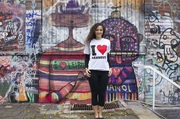Most people visit Stanley Park as its the city's main urban park. Not only does it's beauty attract visitors, but many fail to realize its deep roots with the city. Before the establishment of the city, the land belonged to the Musqueam, Squamish, and Burrard First Nations. The park opened September 27, 1888 and was the city's first green space and still the third largest urban park in North America. The park was named after the govenor of the time, Lord Frederick Stanley. Walk or rent bikes to enjoy a seaside walk overlooking the nearby mountains. It's a must visit for locals and travelers alike.
The totem poles located at Brockton Point in Stanley Park are a must, and some claim is the most visited site in Vancouver. Many of the poles built in the 1880's are now stored in the museum so the ones in the park were built between 1986-1992.
Another noteworthy historical landmark in Stanley Park is the Brockton Point Lighthouse, which was built in 1914.
Gastown is Vancouver's oldest neighborhood, and today one of the hippest neighborhoods in the city. Enjoy modern day cafes, bars, boutiques and restaurants that operate inside of old brick buildings. The neighborhood started with a single tavern, named Gassy Jack Saloon, in 1867 and today is still a must visit. Many visit Gassy Jack Deighton's statue, the original creator of the saloon.
While in the neighborhood be sure to take a look at the 1977 Steam Clock located on the corner of Cambie and Water Streets. This appears as a 19th Century antique clock but was built for modern times in the 70's. The clock rings at every quarter on the hour and releases steam from the top. The clock was featured on the front cover of Nickelback's Here and Now album.
Have a drink at The Diamond which was once home to a brothel.
This is the oldest building in Vancouver, and may very well be the coolest museum in Vancouver. The Hastings Mill Store was built in 1865, twenty-one years before Vancouver became an official city. To signify its age, the house was built when Abraham Lincoln was president of the USA, and built two years before Canada become a country, and six years before BC became a province. The original structure was taken down and moved it in 1930 from Dunley Avenue to Alma Street and Grey Point Road, where locals dazzled up the shack to make it into a museum. And still to this day the house operates as a museum of treasures that once "lived" in Vancouver.
Inside is a world that no longer exists, a true bygone charm, or every vintage lover's wet dream. One of the most prized relics is a panorama of Hastings Mill in 1872, which once hung in the mill's office.
Built in 1939, this is one of the most. historic, and spooky, hotels in Vancouver. The Fairmont recently did a $75 million renovation and although the insides are not that old, the soul of this place is historic. The hotel is supposedly home to the, "Lady in Red," ghost who is often spotted on floor 14. Some claim she stops the elevator at floor 14 even if the button has not been pushed. Staff and guests have spotted this lady, and in her honor the hotel bar has a "Lady in Red" drink named after her.
The Engine 374 Pavilion features the historic transcontinental train engine located on the corner of Davie Street and Pacific Boulevard. According to the Roundhouse.ca website, it states, "May 23, 1887 was a great day for Vancouver, when CPR Engine 374 pulled the first transcontinental passenger train into the city. Crowds cheered, the city band played, ships in the harbour blew their horns, and hundreds of flags decorated the young city. It was a great day not only for Vancouver, but for the whole nation. The event heralded the completion of one of the greatest engineering feats of the century, a twin line of steel linking the new nation of Canada from coast to coast, ten years in construction.
In 1945, after many years of service, including the second World War, Engine 374 was finally retired. The engine was first placed in Kitsilano Park for all to see, and play on, but it suffered greatly from salt air and the passage of the seasons. In 1983, many dedicated citizens came to the engine’s rescue, and began the Herculean task of restoring the engine to its former glory. With additional funds raised through the Heritage Brick Program, the restoration was completed in time for EXPO 86, and there the refurbished engine was a prime attraction."
St. Roch
Inside the Vancouver Maritime Museum is the fully restored 1928 schooner that traversed the Northwest Passage and circumnavigated North America. The Museum features a variety of boats, and considering Vancouver is a water-based city, there is no shortage of boat history here.
What's your favorite historical landmark in Vancouver?
This Lemon Tree article is now featured on GPSmyCity. To download this article for offline reading or travel directions to the attractions highlighted in this article, go to 10 Historical Sites in Vancouver, British Columbia.







 RSS Feed
RSS Feed